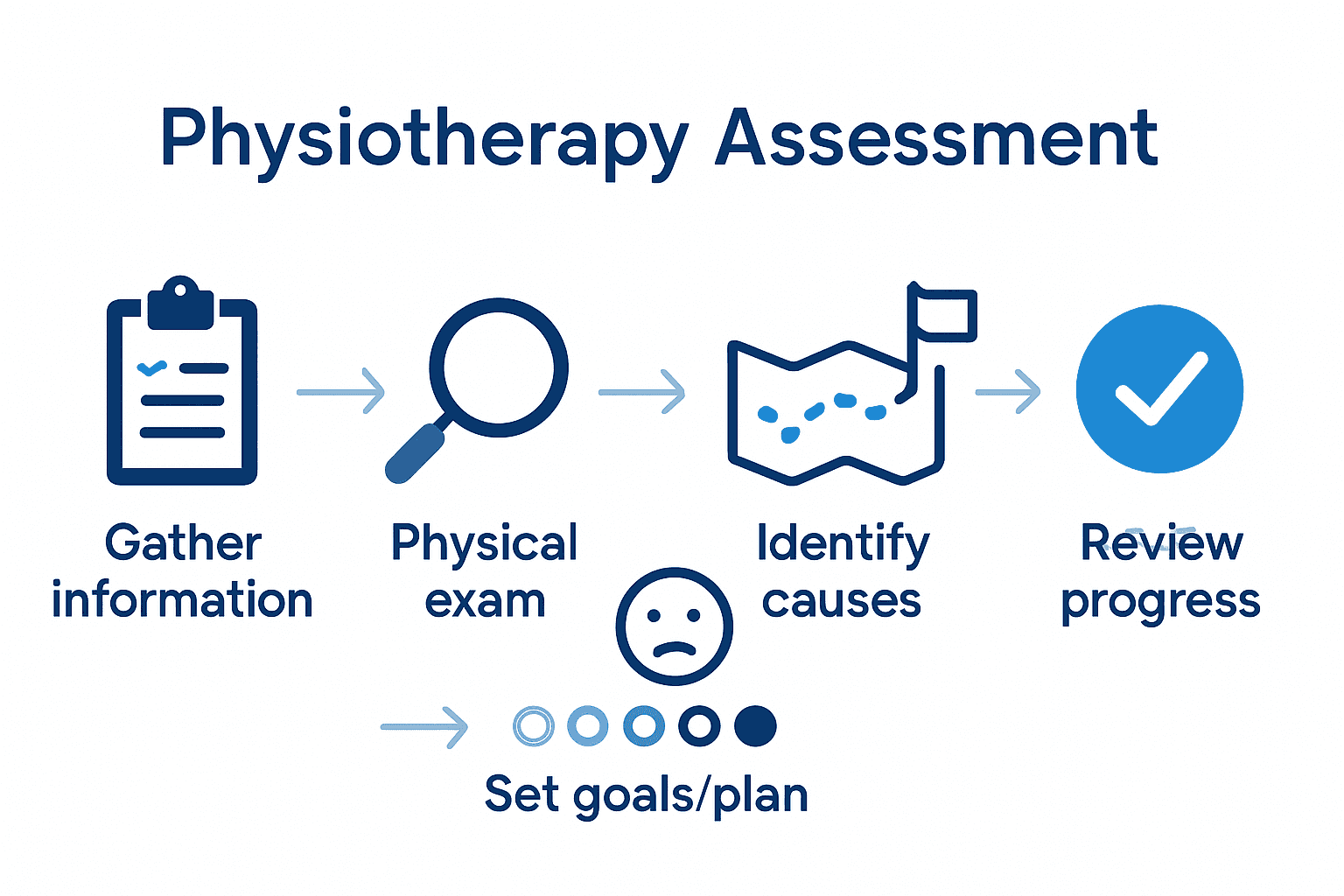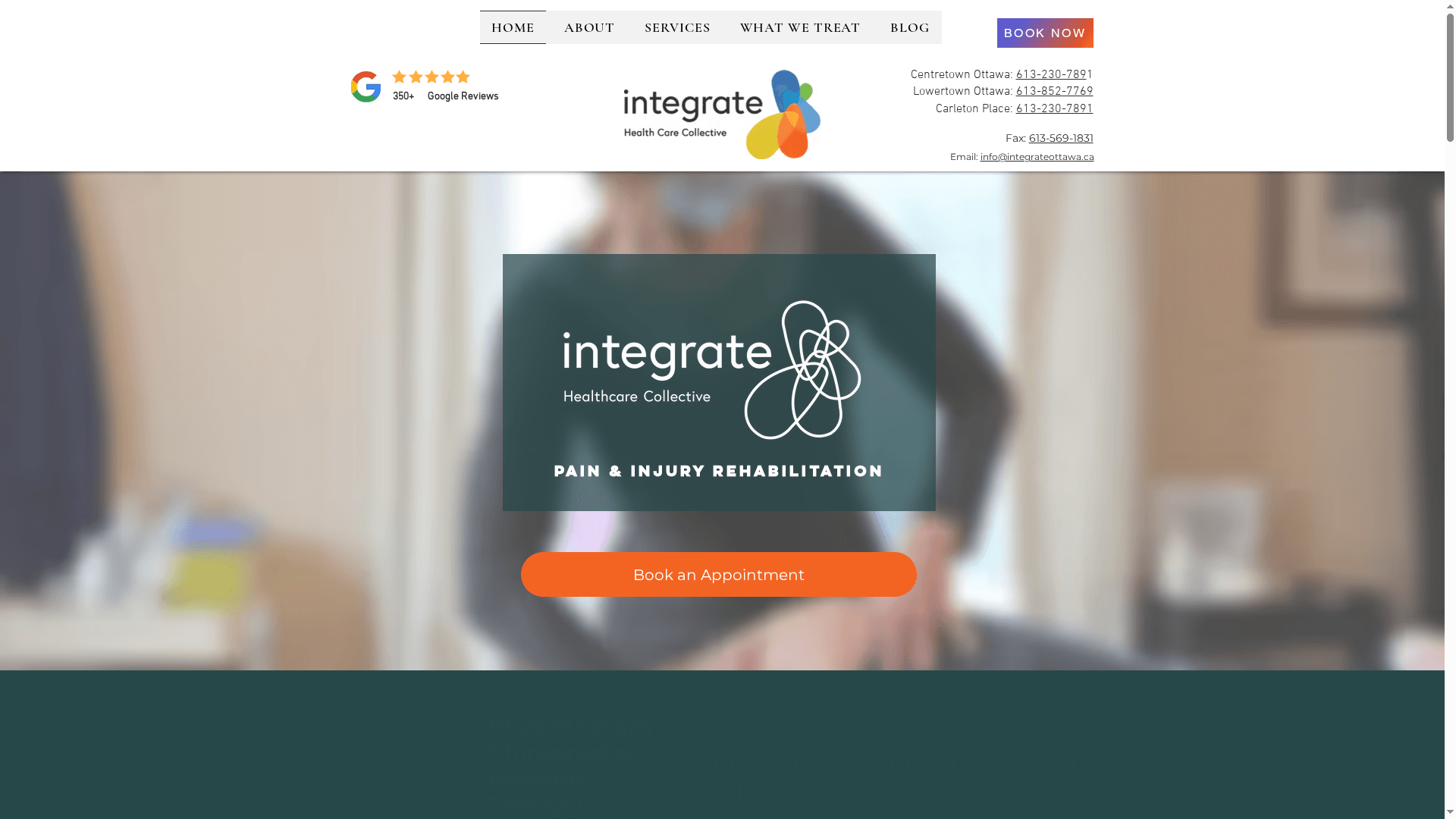Physiotherapy Assessment Process: Step-by-Step Guide for Relief
- 7 days ago
- 7 min read

Most people underestimate how detailed a physiotherapy assessment really is. Professional guidelines require physiotherapists to gather a wide range of medical and lifestyle information before any hands-on evaluation happens. This careful process ensures your treatment addresses your unique needs, not just your most obvious symptoms. By understanding each key stage, you’ll know exactly what to expect and how your active participation shapes a successful recovery.
Table of Contents
Quick Summary
Key Point | Explanation |
1. Collect comprehensive health information | Provide detailed medical and personal history to help tailor your treatment plan effectively. |
2. Participate actively in physical assessments | Engage during tests to ensure accurate evaluations of your mobility and strength. |
3. Identify pain sources systematically | Work with your physiotherapist to pinpoint root causes of discomfort for targeted treatment. |
4. Establish clear treatment goals collaboratively | Set specific recovery objectives together to ensure the plan aligns with your needs. |
5. Regularly review treatment effectiveness | Communicate progress and feedback to adjust your rehabilitation approach as necessary. |
Step 1: Gather Relevant Medical and Lifestyle Information
In this crucial step of your physiotherapy assessment, you will collect comprehensive information about your health history and current condition. According to collegept, obtaining informed consent and applying professional judgment are key foundations for selecting appropriate assessment procedures.
Your physiotherapist will guide you through an in depth interview designed to understand your complete health picture. As outlined by the physiotherapy.ca Competency Profile for Physiotherapists in Canada, this conversation will explore multiple aspects including your current health conditions, personal background, environmental factors, and specific treatment expectations.
During this information gathering process, be prepared to discuss several key areas openly and honestly:
Detailed description of your current symptoms
Past medical history and previous injuries
Current physical activity levels
Work and lifestyle routines
Medications and existing health conditions
Specific goals for physiotherapy treatment
Be transparent and provide as much detail as possible. The more information you share, the more accurately your physiotherapist can develop a personalized treatment strategy. Your openness helps create a targeted approach that addresses your unique physiological needs and wellness objectives.
Next, you will move into the physical examination where your physiotherapist will begin assessing your specific condition through hands on evaluation and targeted movement assessments.
Step 2: Perform Physical Examination and Functional Tests
In this critical stage of your physiotherapy assessment, your healthcare professional will systematically evaluate your physical condition through comprehensive tests and measurements. According to collegept, physiotherapists apply professional judgment to select and perform assessment procedures precisely matched to your presenting symptoms.
The physical examination will involve a series of targeted assessments designed to understand your body’s current functional capabilities. As specified by the physiotherapy.ca Competency Profile for Physiotherapists in Canada, your physiotherapist will carefully select and perform appropriate tests to evaluate your mobility, strength, flexibility, and overall physical performance.
During this examination, you can expect the following key assessments:
Range of motion testing for affected body regions
Strength evaluations using manual muscle testing techniques
Postural and alignment assessments
Neurological screening for sensory and motor function
Specific orthopedic tests targeting your unique symptoms
Functional movement screenings
Your active participation is crucial during these tests. Follow your physiotherapist’s instructions carefully and provide honest feedback about your comfort levels and any sensations you experience. The more accurately you communicate, the more precise your assessment will be.
Proper communication and cooperation during these functional tests allow your physiotherapist to develop a comprehensive understanding of your physical condition. The insights gathered will directly inform your personalized treatment strategy and rehabilitation plan.

After completing the physical examination, you will move to the next stage where your physiotherapist will analyze the collected information and begin formulating a targeted treatment approach.
Step 3: Identify Key Issues and Pain Contributors
In this crucial diagnostic phase, your physiotherapist will transform the collected information into a comprehensive understanding of your specific health challenges. According to collegept, this step requires critical thinking and professional judgment to interpret assessment findings and determine an accurate diagnosis consistent with professional standards.
The analysis process goes beyond simple symptom identification. As outlined by the physiotherapy.ca Competency Profile for Physiotherapists in Canada, your healthcare professional will systematically evaluate multiple dimensions of your condition including body structure impairments, functional limitations, and potential participation restrictions.
During this identification process, your physiotherapist will explore several key areas:
Root cause analysis of your pain or movement dysfunction
Biomechanical assessment of movement patterns
Identification of primary and secondary pain contributors
Evaluation of muscular imbalances or compensatory movements
Assessment of potential systemic or underlying health factors
Determination of how your lifestyle and daily activities impact your condition
Think of this stage as detective work where every piece of information helps construct a complete picture of your physical health. Your physiotherapist will connect the dots between your medical history, physical examination results, and current symptoms to pinpoint the most likely sources of your discomfort.
The insights gained during this step are critical because they directly inform your personalized treatment strategy. By understanding the specific mechanisms contributing to your pain or movement restrictions, your physiotherapist can develop a targeted intervention plan.
Next, you will collaborate with your physiotherapist to discuss the findings and begin developing a comprehensive treatment approach tailored to your unique physiological needs.
Step 4: Establish Personalized Treatment Goals and Plan
This pivotal stage transforms your physiotherapy assessment into a targeted roadmap for recovery. According to collegept, establishing clear physiotherapy goals and determining an intervention plan are essential professional standards that guide your entire rehabilitation journey.
Your physiotherapist will collaborate with you to create a comprehensive treatment strategy that addresses your specific needs. As specified by the physiotherapy.ca Competency Profile for Physiotherapists in Canada, this process involves implementing carefully planned interventions tailored to your unique physical condition and wellness objectives.
When developing your personalized treatment plan, you can expect discussions around:
Short term and long term recovery goals
Specific functional milestones you want to achieve
Frequency and duration of physiotherapy sessions
Recommended home exercise programs
Potential complementary treatment approaches
Strategies for managing pain and improving mobility
Think of this goal setting process as creating a custom roadmap for your body’s recovery. Your active participation is crucial your physiotherapist wants to understand not just your physical limitations but your personal expectations and lifestyle considerations.
A truly effective treatment plan is a collaborative effort. By openly communicating your concerns hopes and realistic expectations you and your physiotherapist can design an approach that feels motivating and achievable.
Once your treatment goals are established your physiotherapist will begin guiding you through the first stages of your personalized rehabilitation program with clear milestones and supportive ongoing assessment.
Step 5: Confirm Assessment Accuracy and Plan Effectiveness
In this critical phase, your physiotherapy journey enters a crucial evaluation stage where your progress and treatment approach will be systematically reviewed. According to collegept, physiotherapists are professionally required to use standardized measures to assess and reassess your condition and track meaningful progress.
The assessment accuracy confirmation involves a comprehensive review of your treatment response and ongoing physiological changes. As outlined by the physiotherapy.ca Competency Profile for Physiotherapists in Canada, your healthcare professional will carefully monitor and respond to your status during interventions while evaluating the overall effectiveness of the established treatment plan.
During this confirmation process, you can anticipate several key evaluation techniques:
Repeated functional movement assessments
Comparative measurements of range of motion
Pain level and intensity tracking
Strength and mobility progression checks
Reassessment of initial treatment goals
Analysis of your subjective experience and feedback
Think of this stage as a performance review for your body. Your physiotherapist will use objective data and your personal insights to determine whether the current treatment strategy is delivering the desired results or requires modification.
Open and honest communication becomes paramount during this evaluation. By sharing your experiences challenges and observations you provide critical insights that help your physiotherapist fine tune your rehabilitation approach.
If adjustments are needed your physiotherapist will collaborate with you to modify the treatment plan ensuring that your path to recovery remains dynamic responsive and precisely targeted to your evolving physiological needs.

Experience a Personalized Physiotherapy Journey for Lasting Relief
Understanding your pain and movement challenges is the first step toward true recovery. This guide highlights the importance of a detailed physiotherapy assessment that gathers your health history, conducts thorough physical examinations, and identifies the root causes of your discomfort. If you are seeking a treatment plan tailored specifically to your needs and goals, it is crucial to work with a team that values evidence-supported, collaborative care.

Take control of your healing process today with expert support from Integrate Ottawa. Their comprehensive services in physiotherapy, chiropractic care, and specialized treatments offer a targeted approach designed to restore function and reduce pain effectively. Learn more about how a customized assessment leads to a clear treatment plan by visiting the Integrate Ottawa homepage. Start your journey to improved well-being now by booking an appointment and experiencing care that adapts as you progress.
Frequently Asked Questions
What information should I prepare for my physiotherapy assessment?
Gather detailed information about your current symptoms, past medical history, medications, and specific goals for treatment. This allows your physiotherapist to develop a tailored approach that addresses your unique needs.
How does the physical examination work during a physiotherapy assessment?
During the physical examination, your physiotherapist will evaluate your mobility, strength, and flexibility through specific tests. Actively participate by following instructions and providing honest feedback to ensure an accurate assessment of your condition.
What are common issues identified in the physiotherapy assessment process?
Common issues include identifying the root cause of pain, evaluating muscular imbalances, and understanding how lifestyle factors contribute to your condition. This analysis helps your physiotherapist develop an effective treatment strategy tailored to your health challenges.
How are personalized treatment goals established in a physiotherapy assessment?
Your physiotherapist will collaborate with you to set clear short-term and long-term recovery goals based on your specific needs and lifestyle. Discuss your expectations openly to help create a motivating and achievable treatment plan.
How can I track my progress during the physiotherapy assessment process?
You can track your progress through regular evaluations that monitor pain levels, mobility, and strength over time. Pay attention to any changes and communicate your experiences with your physiotherapist to ensure your treatment plan remains effective.
What happens if my treatment plan needs adjustments?
If adjustments are needed, your physiotherapist will collaborate with you to modify the treatment plan based on your progress and feedback. Stay engaged in the conversation to ensure your rehabilitation remains responsive to your evolving needs.
Recommended

Comments